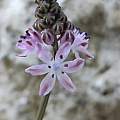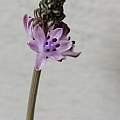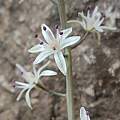Prospero is a European and Mediterranean autumn flowering genus of Hyacinthaceae (or the expanded Asparagaceae) formerly included in Scilla. Flowers appear before the leaves have fully developed; bracts and bracteoles are absent. The Plant List lists 12 species as accepted species. Many of these species are difficult to tell apart. Michael Neumann who has observed this species over the wide range of its distribution observes that there is little variation in plants other than the size. The flower color is always a rosy-pink or lilac-pink (rarely white). The flowering stem is between 6 to 25 cm with 5 to 30 or even more flowers. A plant may develop 1 to 6 scapes. Leaves vary in width and number. Within one population there is variation in these characters. In his opinion there are only four taxa that are distinctive: a variable Prospero autumnale with one form the previous Scilla autumnalis subsp. latifolia deserving subspecies level, another form from southern Turkey also deserving special recognition, and Prospero oppositifolium.
Prospero autumnale (L.) Speta, syn. Scilla autumnalis (L.) is distributed from western Europe and the Mediterranean to the Ukraine, Sardegna (Sardinia), and Turkey. The Plant List shows 33 taxa as synonyms for this genus including ten varieties or forms of Scilla autumnalis and six species of Prospero. Other synonyms listed are Anthericum autumnale (L.) Scop., Genlisa autumnalis (L.) Raf., Hyacinthus autumnalis (L.) E.H.L.Krause, Ornithogalum autumnale (L.) Lam., Stellaris autumnalis (L.) Bubani, and Urginea autumnalis (L.) El-Gadi. Height range: 10-20 cm. Photos below were taken by David Fenwick near Stoke Point and Blackstone Point in South Devon in the UK.
The first four photos below were taken by Michael Neumann. The first shows a wild population taken in the Mani peninsula in Greece and the second in dunes near Arkoudi, Greece. The third compares a plant from Russia on the left with one from Greece on the right. The fourth photo shows a rare white form. Photos five through six were taken near Levanto, Italy (Liguria) by Mary Sue Ittner.
The form previously named Scilla autumnalis subsp. latifolia Iatroú & Kit Tan was described in Endemic Plants of Greece, The Peloponnese (2001) from only the southern most tip of Mani Peninsula in Greece. It is not currently accepted as a subspecies in Prospero. Around Porto Kagio you will find a totally uniform population of plants with wide leaves, as the name implies, flat on the ground and dense pyramidal flower spikes, which are densely packed with flowers of an always rosy pink color. This population is totally different from all around, which justify a subspecies. Photo and description from Michael Neumann.
Occasionally one sees the name Prospero autumnalis subsp. latifolium. Photo by Thim Fielmich.
Photos below are of a Prospero species that was brought from southern Turkey, Antalya Province, many years ago by a friend. It is huge! The bulbs are up to 6 cm in diameter and produce lots of side bulbs, which other forms of Prospero autumnale never do. The scapes are up to 50 cm high and in all part bigger. Photos 1-3 below show the flowers and photos 4-5 compare the bulbs and the size of the plant from southern Turkey on the left with a cultivated form from Greece on the right. Photos and description from Michael Neumann.
Prospero battagliae Speta, syn. Scilla battagliae (Speta) Valdés, is native to Crete. Photo by Thim Fielmich.
Prospero depressum Speta, syn. Scilla depressa (Speta) Valdés, is native to Crete.
Prospero elisae Speta, syn. Scilla elisae (Speta) Valdés, is native to Albania and Yugoslavia.
Prospero hanburyi (Baker) Speta, syn. Scilla hanburyi Baker, is distributed from Syria to Sinai. Photo by Thim Fielmich.
Prospero hierapytnense Speta, syn. Scilla hierapytnense (Speta) Valdés, is native to Crete.
Prospero idaeum Speta, syn. Scilla idaea (Speta) Valdés, is native to Crete.
Prospero minimum Speta, syn. Scilla minima (Speta) Valdés, nom. illeg., is native to Crete.
Prospero obtusifolium (Poir.) Speta, syn. Scilla obtusifolia Poir., is a Western Mediterranean species (Algeria, Balearic Islands, Corsica, Libya, Morocco, Sardegna (Sardinia), Sicily, Spain). It has leaves 1 cm wide, which lay on the ground like a star. Flowers are bigger, with scapes loosely packed with flowers of an always rosy-pink color. This species flowers earlier than Prospero autumnale. Height: 20 cm. Photos from Gottfried Milkuhn.
Prospero paratethycum Speta, Scilla paratethyca (Speta) Valdés, is a NW. Balkan Peninsula species.
Prospero rhadamanthi Speta, syn. Scilla rhadamanthi (Speta) Valdés, is native to Crete. Photo by Thim Fielmich of an example from "a very small population on a rocky outcrop on Petres beach on Crete"
Prospero talosii (Tzanoud. & Kypr.) Speta, syn. Scilla talosii Tzanoud. & Kypr., is native to Crete.
























